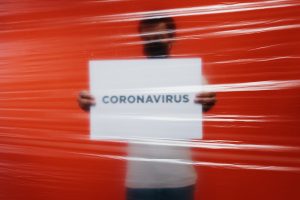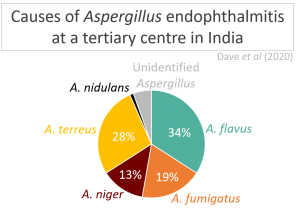Submitted by Aspergillus Administrator on 1 March 2012
A competition – the first of its kind to explore the relationship between fungi and and the illnesses that they cause using art and music – launches this week across the region’s schools.
For the next ten weeks thousands of young people in more than 400 schools in the North West and North Wales will be invited to interpret how they see the deadly role fungus can play in human diseases through creative arts and music.
Project Director, Professor David Denning explains: “Fungi are beautiful and fascinating they are essential to our ecosystem in the carbon and nitrogen cycles, and are valuable in commerce. Many industries use “good” fungi, for example in the making of alcohol, bread and cheese. However some fungi can also cause human infection. Fungal infections are mostly hidden and diagnosis is often missed. As many as 300 million people worldwide are affected, in many different forms of illness, some of which are deadly. This is an exciting project because never before has the mystery and beauty of microscopic fungi been explored in art and music.”
The competition is being run by LIFE Worldwide which has three fundamental aims:
Ø To promote awareness of LIFE and its aims through the work of young artists and musicians
Ø To give budding artists and musicians the recognition they deserve by promoting their talents
Ø To educate young people about fungi and how they can cause illness.
The project, which is open to all young people aged between 13 and 18 and has a deadline of April 29th , is supported by the UK charity the Fungal Research Trust and the University Hospital of South Manchester. This is based at Wythenshawe Hospital
The competition website can be found at www.projectlifecompetition.org. It includes videos of interviews with patients living with fungal disease and a photo gallery displaying the vast array of different types of disease causing fungi.
Winning entries to the competitions will be receive an individual winners cash prize and a separate cash prize will be awarded to their School. Other prizes will include the opportunity for valuable work experience in a clinical environment. The panel of judges includes:
• Clark Rundell, Director of Contemporary Music and Head of Conducting at the Royal Northern College of Music in Manchester
• Dr Lizzie Burns, Director of Science to Life, Oxfordshire
• Sally Nash, a Landscape Architect with Gillespies in Manchester
• Bob Devereux, Poet, Artist and Gallery Director of the Salthouse Gallery in St Ives, Cornwall
Background on LIFE:
LIFE is the international education and advocacy brainchild of the UK UK
Fungal infection
Over 300 million people are acutely or chronically infected by fungi, leading to death, long term illness, blindness, psychological problems and reduced work capacity. These diseases have mostly been neglected. Many recent improvements in diagnostics and treatment have not reached treating clinicians in all countries, and access to appropriate diagnostics and simple antifungal agents is far from universal.
Deaths from fungal infections
Ø Cryptococcal meningitis – 10% death rate in the USA , >80% in Africa . 600,000 deaths annually. Diagnosis simple with antigen test, but often late and appropriate medication not available.
Ø Invasive aspergillosis – 200,000+ cases annually; 50% mortality treated, 100% if not, >100,000 deaths. Diagnosis difficult; treatment often too late, and only partially effective.
Ø Chronic pulmonary aspergillosis – ~3 million cases and 450,000 deaths; diagnosis often confused with TB, and requires radiology and aspergillus antibody test; 30% mortality in 6 months, often by coughing up blood. Treatment partially successful but long term.
Ø Pneumocystis pneumonia – ~ 400,000 patients annually; ~15% mortality in UK in AIDS, ~50% non-AIDS, 100% if not diagnosed and treated. >80,000 deaths. Diagnosis difficult without PCR or fluorescence microscopy. Treatment straightforward and available.
Ø Candida bloodstream infection – 300,000+ cases worldwide; ~40% mortality, treated. ~120,000 deaths. Diagnosis by blood culture. Treatment straightforward, best drugs expensive.
Ø Severe asthma with fungal sensitization (SAFS) – probably over 3.5 million patients worldwide; increased risk of asthmatic death (estimated to be 100,000 annually worldwide).
Major fungal infections and their impact or health and wellbeing
Ø Oral and oesophageal thrush – unpleasant, reduced food intake and weight loss.
Ø Allergic bronchopulmonary aspergillosis (ABPA) [~4 million people worldwide] and SAFS – breathlessness with severe asthma, reducing work capability especially for manual workers, co-morbidity issues with smoke from home cooking – easy diagnosis (skin prick tests), if considered, antifungal treatment 60-80% effective.
Ø Chronic pulmonary aspergillosis – progressive breathlessness and weight loss, with significant hospitalisation and medication costs (typically mis-directed).
Ø Fungal eye infection – ~1 million cases annually; usually results in unilateral blindness as diagnosis late, good outcome if treated early. Diagnosis requires expert input; treatment intensive initially but unaffordable for most afflicted.
Ø Candida vaginitis – ~75 million women with at least 4 attacks a year; mis-diagnosis and anxiety major problems; impaired sex life and therefore relationship issues.
Ø Fungal hair infection – over 100 million children affected; most common in black children, who suffer patches of hair loss, exclusion from school and psychological problems as a result. Diagnosis and treatment usually straightforward and highly effective.
News archives
Showing 10 posts of 953 posts found.
-
Title
Date



